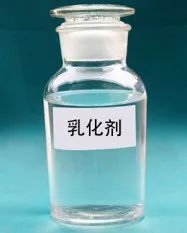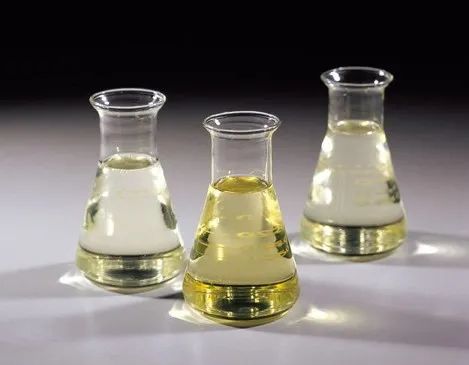Prepare amino silicone oil first
The production method of using D4 or DMC to make amino silicone oil is as follows:
Hydrolysis of coupling agent
First put 100kg of piperazine-based coupling agent into the reaction kettle, add 20kg of deionized water, start stirring, open the drain valve of the receiver, raise the temperature, and when it reaches 80°C, turn on the cooling water of the condenser and continue When the temperature rises to 130°C, close the evacuation valve and turn on the vacuum. During the vacuuming process, the temperature of the material is reduced to 150°C, cooled to below 80°C, discharged, and weighed.

Yield = weight after dehydration/input amount (usually 0.8)
2. Synthesis of amino silicone oil
Pump 200kg of DMC into the reaction kettle. When the temperature rises to 80°C, add (20g potassium hydroxide + 180g water), raise the temperature to 145~150°C, and after 1 hour of heat preservation, measure the viscosity at 2000~5000CP. There is no need to lower the temperature. Add a completely hydrolyzed piperazine-based coupling agent, such as 0.6N (12kg*yield), then add potassium hydroxide (20g potassium hydroxide + 20g water), and keep it warm at 145+150°C for 1 hours, the viscosity is above 5000. It can be cooled to below 80℃. If the viscosity of the discharged material is high, vacuum reaction can be carried out before cooling down to the required viscosity. If the viscosity is required to be small, MM or MDM head sealing agent can be added before cooling down, and then the catalyst can be added to reduce the viscosity.
Oils produced with D4 or DMC are: 0.6N with a viscosity of 5000 to 1000CP, and 0.9N with a viscosity of 1000CP.

Reference for the applicable range of amino silicone oil with different ammonia values
0.02-0.1N is suitable for use as a deepening agent
0.1-0.2N is suitable for smoothing agent
0.2-0.3N polyester nylon softener
0.3-0.4N cotton softener
0.4-0.6N cotton and wool soft finishing agent
0.6-0.9N acrylic, rayon soft finishing
Triamine piperazine 0.3-0.5N soft finishing of cotton, rayon and acrylic fiber
Piperazine 0.3-0.5N soft finishing of cotton and rayon
The effect of coupling agents on the quality of synthetic amino silicone oil

1. 602 coupling agent
602 is the most commonly used silane coupling agent. It has the advantages of good hand feel and strong versatility on various types of fabrics. The disadvantage is that it has large yellowing properties and is greatly restricted in application.
2. KH550
When used to make amino silicone oil, water cannot be added to the coupling agent. It is usually used in large quantities in emulsion polymerization. It has the advantages of less yellowing, high self-crosslinking elasticity, and is used for smooth, rebound and stiff finishing.
3. Piperazine-based coupling agent
Because the amino group in the piperazine-based coupling agent is not exposed, it has the characteristics of less yellowing and semi-hydrophilicity, and is widely used in the finishing of cotton fabrics, acrylic fibers, and rayon.
4. Triaminopiperazine
Triaminopiperazine has one more group than the piperazine-based coupling agent, so it has more fluffy properties and is widely used for fluffy finishing of cotton and rayon.
5. 560 coupling agent
560 coupling agent is a self-crosslinking coupling agent with epoxy groups. It has no yellowing effect on fabric finishing. It is mostly used in emulsion polymerization. It makes the finished fabric dry, smooth and elastic.
Selection of emulsifier
1. TO isotridecyl alcohol series
Because the TO series has extremely strong emulsification and penetration properties, it is widely used as an emulsifier for smoothing agents, wool mercerizing softeners, etc. The disadvantage is that the amino silicone oil cations emulsified with the TO series have strong polarity and are easy to color and stick. Roller, use less on long car finishing agents.
2. XL isomeric ten alcohol series
It has moderate emulsification penetration and is widely used in cotton chemical fiber finishing agents.
3. Fatty alcohol AEO series
The emulsification penetrating power is poor, especially the softener used for cotton fabrics, which can reduce the sticking phenomenon.
4. The choice of emulsifier is very important in smoothing softeners. Generally, two series are selected in one smoothing softener for a more ideal effect.
Production of mercerized silicone oil
The recipe is as follows:
5 million viscosity hydroxyl silicone oil 20kg
1 million viscosity hydroxyl silicone oil 10kg
0.03-0.05N amino silicone oil
500,000-1 million CP 20kg
0.1-0.15N amino silicone oil
50,000-100,000 CP 20kg
0.4-0.45N amino silicone oil
20,000-50,000 CP20kg
0.6-0.9N amino silicone oil
5000-10,000 10kg
Emulsifier T05 10-15kg
T07 10-15kg
Glacial acetic acid 1kg
Glycerin 100-200kg
Cross-linking agent 2-3kg
Water 150kg
Add various amino silicone oils and hydroxyl silicone oils in the formula into an emulsification kettle equipped with high-speed dispersion and wall scraping devices. Stir at high speed for 2 hours. The temperature of the material will rise rapidly and reach about 90°C. At this time, amino silicone oil and hydroxyl silicone oil will react to redistribute the structure. The amino groups in the amino silicone oil will be transferred to the hydroxyl silicone oil, and the hydroxyl groups of the hydroxyl silicone oil are partially combined with the amino groups. After the materials are mixed and degraded, cool down to below 40°C, add cross-linking agent, add emulsifier, stir for 10-20 minutes, add 1kg of glacial acetic acid to 10kg of water, the so-called acid water, and slowly add it to the emulsification kettle. , stir for 10-20 minutes, then add glycerol in batches, and then slowly add water. Stilling, filtering, packaging.
The role of hydroxyl silicone oil and cross-linking agent
Hydroxysilicone oil determines the style and refractive index of fabric finishing, which is specifically reflected in the thickness, resilience, gloss and smoothness of the fabric.
The fleshy, thick, mirror-like and smoothness of the fabric are due to the use of hydroxyl silicone oil with a viscosity of 5 million; the smoothness, brightness and deepening of the fabric are due to the use of hydroxyl silicone oil with a viscosity of 1 million; and amino acids with low ammonia value Silicone oil; the dryness of the fabric or the non-sticky silicone oil lies in the cross-linking agent. Commonly used cross-linking agents include highly hydrogenated silicone oil, KH550, KH560, methyltriethoxy, etc. The soft and fluffy feel of the fabric lies in the amino silicone oil with medium and high ammonia values.
Application of mercerized silicone oil
In principle, mercerized silicone oil is ice-like silicone oil. It is mainly used for mercerized cotton, cotton stretchers, imitation mercerization, woolen sweaters, wool, woolen fabrics, leather feel agents, and denim finishing.